Microsoft Surface Review
by Anand Lal Shimpi on October 23, 2012 9:01 PM EST- Posted in
- Tablets
- Microsoft
- Mobile
- Surface
- Windows RT
Display: Not Retina, But Still Good
Surface features a 10.6 inch, 1366 x 768 16:9 display. The physical size is a bit unusual, although the display resolution is something we’ve seen used in affordable notebooks for years now. We already know why Microsoft picked the display size (to enable better multitasking and make for a good keyboard size), but is there room for a flagship tablet with only a 1366 x 768 display resolution?
Microsoft’s response to the resolution question is that more pixels isn’t necessarily better, and that there are a number of other factors that are just as important. It also is quick to point out that a significantly higher resolution display would have increased memory bandwidth requirements, decreased UI frame rate and required a larger battery. As NVIDIA’s Tegra 3 only has a single channel LPDDR2 memory interface, driving a 2048 x 1536 panel and maintaining Microsoft’s UI performance requirements was out of the question. Apple ran into the same issue and ended up building the A5X SoC with an insanely wide memory interface to deal with it. Down the road I’d expect the memory bandwidth problem to get solved, but that still leaves a power consumption issue. Apple moved to a 42.5Wh battery in the 3rd generation iPad, a 37% capacity increase compared to the 31Wh unit in Surface. Enabling a similar panel would have pushed size and weight of Surface more than Microsoft would have liked.
Given those constraints Microsoft chose a different route with Surface. Rather than focus on pixel density it focused on improving contrast and reducing glare. Surface laminates the cover glass and LCD panel together, removing an annoying air gap that’s responsible for some reflections/glare and a reduction in brightness. Apple’s recently announced 8th generation iMac does something similar, as do a lot of high end smartphones, but Surface is among the first to do so with a ~10-inch LCD. The effect is noticeable in a contrived photo but it also results in a display that’s not half bad to look at.
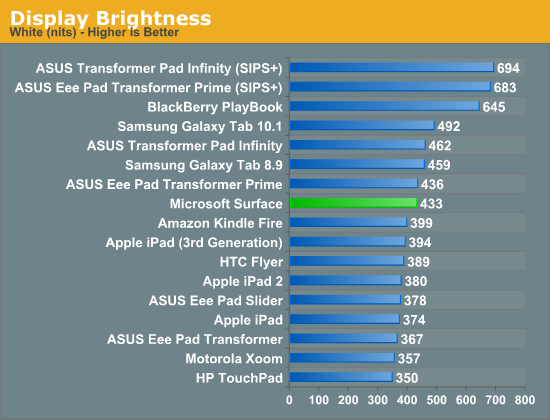
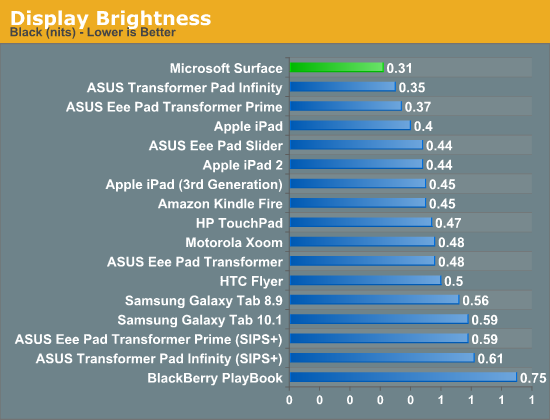
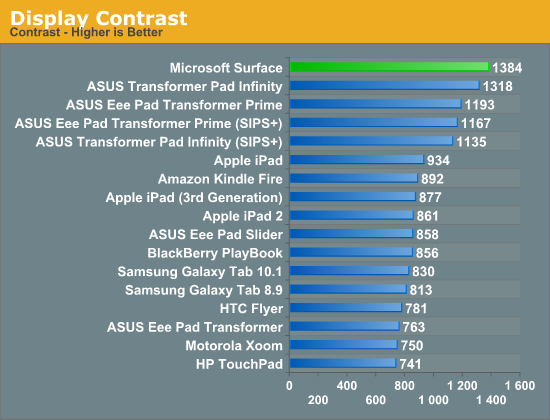
With the exception of text on web pages, the lower resolution Surface display isn’t overly bothersome. I would like something a bit higher resolution although I don’t know that matching Apple’s pixel density is absolutely necessary if Microsoft can deliver elsewhere.
Apple doesn’t just rely on resolution to sell the iPad’s Retina Display, it also happens to do quite well at accurately representing colors. I put Surface through AnandTech Senior Display Editor, Chris Heinonen’s excellent tablet/smartphone analysis workflow to see how well it did:
| CalMAN Display Comparison | ||||||
| Apple iPad (3rd gen) | Apple iPad 2 | ASUS Transformer Pad Infinity | Microsoft Surface | |||
| Grayscale 200 nits Avg dE2000 | 3.7333 | 1.3826 | 3.9881 | 3.6769 | ||
| CCT Avg (K) | 6857K | 6632K | 6632K | 6407K | ||
| Saturation Sweep Avg dE2000 | 3.193 | 6.8404 | 6.8404 | 7.3617 | ||
| GMB Colorchecker Avg dE2000 | 3.0698 | 3.8957 | 4.4177 | 5.3057 | ||
Saturation

Gamut
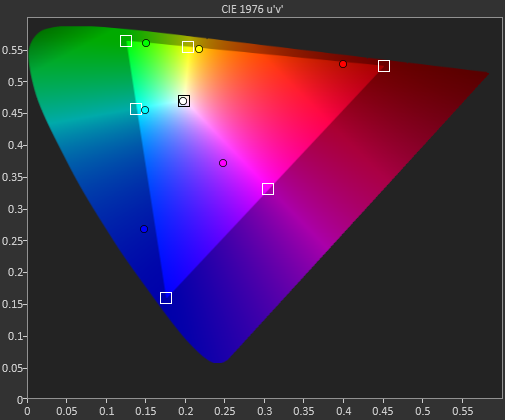
GMB Color Checker
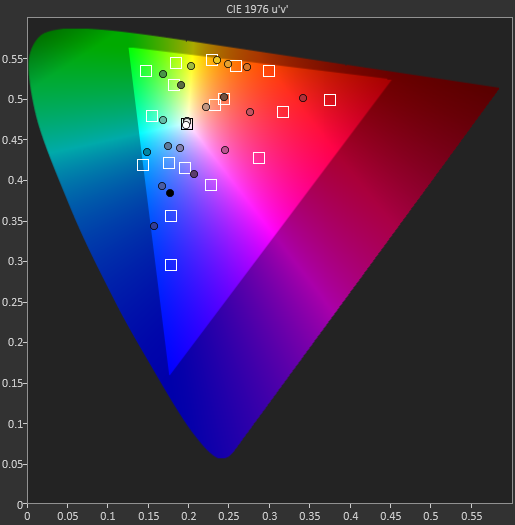
Grayscale accuracy is slightly better on Surface compared to the iPad, however the rest of the accuracy metrics show Apple’s tablet ahead of Surface.
This isn’t to say that Surface’s display is bad, in fact I think it’s quite good and I’d argue that it was never a problem in my testing, but it’s definitely not the best on the market today. I’m also not sure how much of this has to do with Microsoft’s panel selection vs. software calibration. None of my calibration tools work under Windows RT so I couldn’t really tell you.
I did reach out to Microsoft and they did say that some of my values in the charts below looked a little off. I’ll be rerunning data on another Surface sample as soon as I get a chance to.










235 Comments
View All Comments
sviola - Wednesday, October 24, 2012 - link
Care to source the claim that A6 performs the same as x86 core processors per clock cycle?blandge - Wednesday, October 24, 2012 - link
"A6 is as fast as Intel per clock cycle. (and yes: I understand that A6 is dual core and intel is quad + clocked much higher. But the fact is that A6 is as fast per clock cycle. ARM will replace X86)"This simply isn't true. The A6 scored 908ms on the SunSpider browser benchmark and a 2700k scores about 135ms (Lower is better). That's about 6x better, and SunSpirder is a SINGLE CORE benchmark.
Brainling - Wednesday, October 24, 2012 - link
Are you serious with this about the A6? The A6 is NO WHERE NEAR as fast as full on Intel silicon. It's not even in the same ballpark. Maybe if you're comparing it to Atom?An Ivy Bridge full silicon CPU is in another league over the A6. Of course, they aren't meant for the same purpose. Even taking the faster clocks in to account (~4x the clock speed), the Ivy Bridge regularly scores 6-7 times the execution scores of an A6 in synthetics. That's not pure clock speed, that's also a flat better CPU.
I swear...some of this stuff is just mind blowing. What in the world would have ever made you think an A6 was "clock for clock" as fast as Intel's best offerings? Also, the XBox 360 doesn't use an Intel CPU or an x86 CPU...it's a Motorola PowerPC. Might wanna check your facts next time.
Kevin G - Tuesday, October 23, 2012 - link
A typo: "Microsoft offers Touch Cover in six colors black, white, magenta, cyan and red." Not sure if a color is missing or you meant five (though five pictured).Anand, you've been taking the Surface around judging the examples in the article. Any chance it was with you during the iPad mini event? I can image the looks being worse than when you tried to make a call at the iPhone 5 event.
"Simply typing quickly in Microsoft Word maxes the single threaded performance of Tegra 3’s ARM Cortex A9 cores." It does seem odd that one of Surface's biggest selling points on the software side is a self inflicted wound. Office should be the premiere application for MS to show case, not bloatware that'd deserve to sit in the sloth exhibit at a zoo. Was Office even usable?
Ryan Smith - Tuesday, October 23, 2012 - link
Apparently we can't count today. It is indeed five colors, not six.ssiu - Tuesday, October 23, 2012 - link
Finally, some objective Windows RT versus Windows 8 Atom tablet performance comparison on the net -- thanks anandtech. Definitely no reason for me to consider Windows RT.Zink - Tuesday, October 23, 2012 - link
Yep this is silly. The only reason for RT is to let OEM's compete <$500 with Apple and to emulate other walled garden ecosystems.Atom should have been launch hardware for a better user experience. Hasn't Apple success shown that UI is #1?
dagamer34 - Tuesday, October 23, 2012 - link
Basically it seems like Microsoft built a rather competent product, and when we see Windows RT tablets with stronger hardware like Tegra 4 or S4 Pro, it should be a great experience.Considering this is Microsoft's first hardware computer, they could have done a LOT worse, and there are some things you only learn by actually shipping a product. For a 1st gen release, that's pretty good.
shompa - Wednesday, October 24, 2012 - link
Thats is one of MSFT problem. Since they control the hardware, we wont see the crazy Android/PC hardware wars. How long time for MSFT to write drivers/support Tegra4 or any other fast SoC?Just look at Windows Phone. Nokia have the killer "Pure View" and MSFT don't support it.
(And thats is why Nokia will die with only MSFT support)
notanakin - Tuesday, October 23, 2012 - link
"Microsoft’s talents not as a software developer nor as a parts assembler are what make Surface great here, rather its design and manufacturing intuition."Er, so what is it that makes Surface great here? Almost sounds like the less talent you have, the greater the product. (In that case, please contact me for insanely great product designs.)